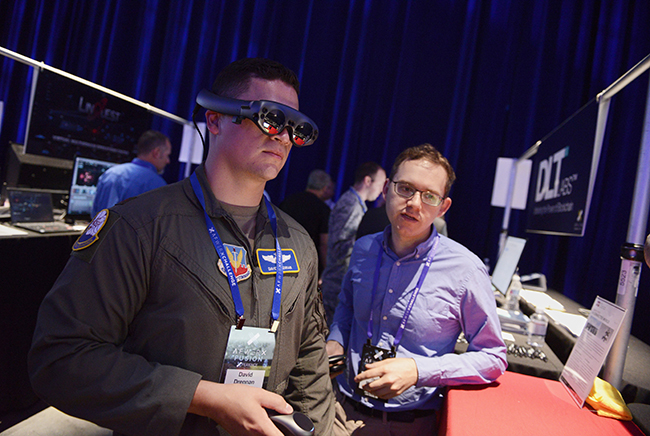
Airmen interacted with about 120 businesses that pitched their products at a multi-domain operations-focused AFWERX event held July 23-24, 2019, in Las Vegas. Photo courtesy of AFWERX.
LAS VEGAS—Tucked in a conference center on the outskirts of this growing technology hub, the Air Force is taking new steps to move multi-domain operations from a headquarters-level conversation to one tackled in all corners of the service.
Multi-domain command and control, part of the broader multi-domain operations concept, has been one of the Air Force’s top focuses under Chief of Staff Gen. David Goldfein since 2016. It was the subject of a yearlong enterprise study that ran into 2017, then quietly morphed into a further research effort at Hanscom AFB, Mass.
A recent gathering here hosted by AFWERX, the Air Force’s innovation organization, aimed to streamline the process of connecting airmen with data-driven tools, even as bigger policy and operational questions are still being answered in the service’s top echelons.
“We have committed to figure out, what can we do from a production perspective” said Maj. Gen. Michael Fantini, Air Force Warfighting Integration Capability director. “Our vision is to stand up 10 cross-functional teams. It’s going to cover enterprise solutions, soup-to-nuts, from generating combat power from inside the proverbial contested environment, generating combat power outside the contested environment, what does space look like, what does cyber look like in the future”
One of those teams, focused solely on MDC2, will work closely with the Advanced Battle Management System architect as well as the chief information officer and chief data officer.
Some say multi-domain operations are already happening while others say being truly multi-domain is a far-off goal, riddled with technological, cultural, and security hurdles. The concept envisions a more interconnected way of waging war where algorithms crunch data and help service members plan and react faster than before, while deciding which air, space, cyber, land, or sea asset is best suited to each situation.
Until that bigger vision comes to fruition, airmen came to the gathering to check out artificial intelligence software, mapping tools, sensors, communications systems, and more that could help accomplish their own missions.
AFWERX’s “Fusion Xperience” brought together about 120 businesses and ultimately awarded 30 companies of all sizes the chance to further prove their merit at another event in September. While the competition offers a different paradigm than the multimillion-dollar contracts typical of larger military acquisitions, its investments show that the Air Force is starting to take new steps toward MDO. That’s likely welcome news to contractors who have been eyeing this space for years but are skeptical about the service’s willingness to go all in.
“From an industry perspective, we’re looking to actually see if the Air Force and DOD walk the talk,” said Mike Boera, Air Force strategic account executive at Leidos. “That may come with open mission systems, standardization, and putting money towards the less sexy things. Is [MDC2] getting the prioritization that is needed”
Event attendees came from as close as Creech AFB, Nev., to as far as JB Elmendorf-Richardson, Alaska, and Australia. Visitors from the 557th Weather Wing at Offutt AFB, Neb., said they saw 10 or 15 data-analysis tools and other products they’d like to use. The wing offers weather forecasting and modeling information to the Defense Department that shapes troop movements and combat operations.
“MDO is all about decision-making, so the faster that we can process our information, the faster that we can make adaptations to our software applications, the faster we can do that and get the information to decision-makers [that] makes it more relevant,” 16th Weather Squadron Commander Lt. Col. Jeff Cunningham said. “If the decision is five minutes late, it’s not useful.”
Col. Russ Hart, Air Force Global Strike Command’s director of studies, analyses, assessments, and leadership development, said the command was looking for products that can more effectively integrate how the Air Force uses its nuclear, space, cyber, and conventional assets.
For Air Education and Training Command, multi-domain ops is one of the driving forces behind initiatives like “Pilot Training Next.”
“It’s going to require a new learning paradigm for the command, for the Air Force to engage in—one that prepares people for a much higher degree of ambiguity, much higher degree of creativity and decision-making without guidance, and in many cases, without the ability to go call anybody for help,” Lt. Col. Eric Frahm, an AETC technology official who also works with AFWERX.
He also pointed to virtual-reality tech shown at the AFWERX competition that AETC could use to train maintainers, tanker operators, and pilots.
How the Air Force and the DOD more broadly would govern multi-domain operations remains to be seen. Those decisions can help drive how the services decide to adopt new and build jointly usable software systems.
AFWERX Chief Executive Officer Brian Maue said officials from AFWIC, a cross-functional planning group within Air Force headquarters, as well as the Advanced Battle Management System effort are interested in products exhibited at this year’s Fusion Xperience. That high-level collaboration can offer the Air Force a more holistic, bird’s-eye view of how different technologies could work together in the real world.
“We have definitely been integrated with both our acquisition partners and our AFWIC partners, so that [for] those items that are a good fit with their general plans, we will push forward,” Maue said.